《从零实现哈希表:详解设计、冲突解决与优化》
文章目录
一、哈希概念

1.1 直接定址法


1.2 哈希冲突

1.3 负载因子

1.4 将关键字转为整数

1.5 哈希函数
一个好的哈希函数应该让N个关键字被等概率地均分的散列分布到哈希表的M个空间中,
但是实际中却很难做到,但是我们要尽量往这个方向去考量设计
1.5.1 除法散列法/除留余数法



1.5.2 乘法散列法

1.5.3 全域散列法
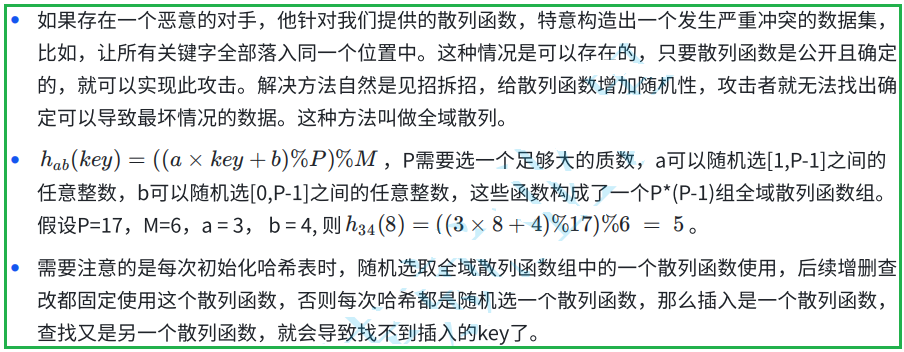
1.6 处理哈希冲突
实践中哈希表一般还是选择除法散列法作为哈希函数,当然哈希表无论选择什么哈希函数也避免不了冲突, 解决冲突的两种方法:开放定址发和链地址法
1.6.1 开放定址法

线性探测

二次探测

双重散列
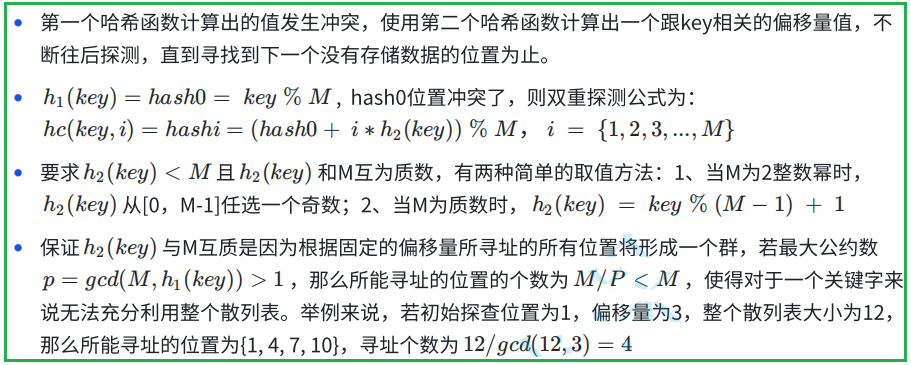
1.6.2 开放定址法代码实现
开放定址法在实践中,不如下面讲的链地址发,因为开放定址法解决冲突不管使用哪种方法,
占用的都是哈希表中的空间,始终存在互相影响的问题。
所以开放定址法,我们简单选择线性探测实现即可
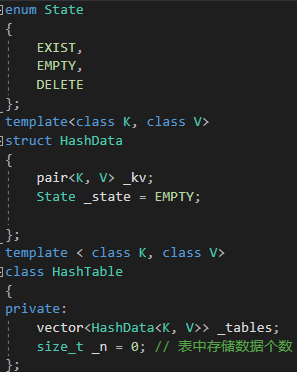
开放定址法的哈希表结构:代码如下(示例):
enum State
{
EXIST,
EMPTY,
DELETE
};
template<class K, class V>
struct HashData
{
pair<K, V> _kv;
State _state = EMPTY;
};
template < class K, class V>
class HashTable
{
private:
vector<HashData<K, V>> _tables;
size_t _n = 0; // 表中存储数据个数
};

扩容

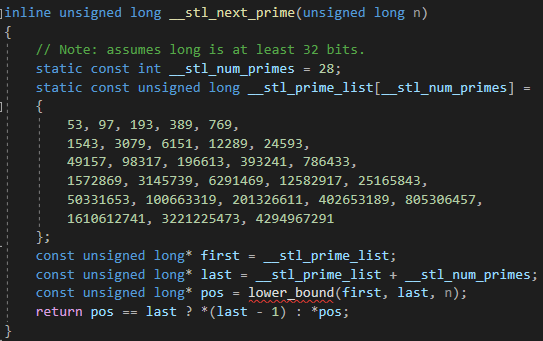
代码如下(示例):
inline unsigned long __stl_next_prime(unsigned long n)
{
// Note: assumes long is at least 32 bits.
static const int __stl_num_primes = 28;
static const unsigned long __stl_prime_list[__stl_num_primes] =
{
53, 97, 193, 389, 769,
1543, 3079, 6151, 12289, 24593,
49157, 98317, 196613, 393241, 786433,
1572869, 3145739, 6291469, 12582917, 25165843,
50331653, 100663319, 201326611, 402653189, 805306457,
1610612741, 3221225473, 4294967291
};
const unsigned long* first = __stl_prime_list;
const unsigned long* last = __stl_prime_list + __stl_num_primes;
const unsigned long* pos = lower_bound(first, last, n);
return pos == last ? *(last - 1) : *pos;
}
key不能取模的问题

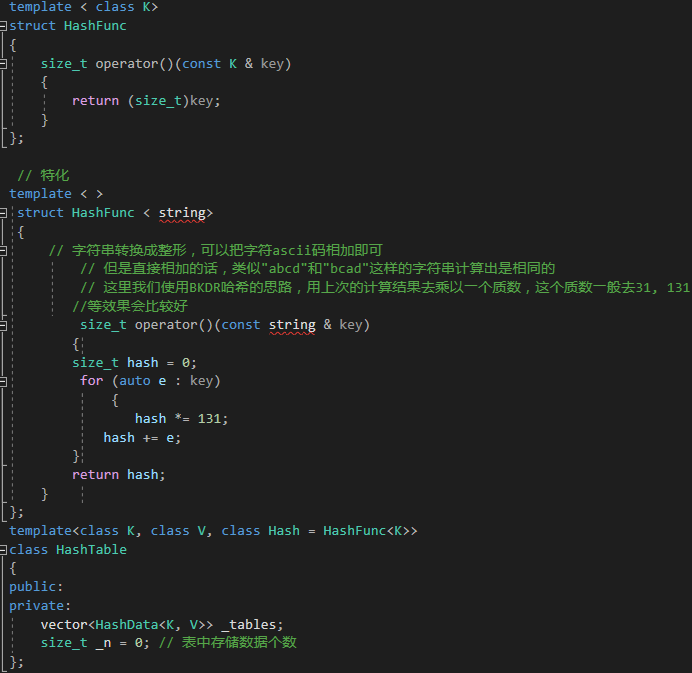
代码如下(示例):
template < class K>
struct HashFunc
{
size_t operator()(const K & key)
{
return (size_t)key;
}
};
// 特化
template < >
struct HashFunc < string>
{
// 字符串转换成整形,可以把字符ascii码相加即可
// 但是直接相加的话,类似"abcd"和"bcad"这样的字符串计算出是相同的
// 这⾥我们使⽤BKDR哈希的思路,⽤上次的计算结果去乘以⼀个质数,这个质数⼀般去31, 131
//等效果会⽐较好
size_t operator()(const string & key)
{
size_t hash = 0;
for (auto e : key)
{
hash *= 131;
hash += e;
}
return hash;
}
};
template<class K, class V, class Hash = HashFunc<K>>
class HashTable
{
public:
private:
vector<HashData<K, V>> _tables;
size_t _n = 0; // 表中存储数据个数
};
完整代码实现
代码如下(示例):
namespace open_address
{
enum State
{
EXIST,
EMPTY,
DELETE
};
template<class K, class V>
struct HashData
{
pair<K, V> _kv;
State _state = EMPTY;
};
template<class K, class V, class Hash = HashFunc<K>>
class HashTable
{
public:
inline unsigned long __stl_next_prime(unsigned long n)
{
// Note: assumes long is at least 32 bits.
static const int __stl_num_primes = 28;
static const unsigned long __stl_prime_list[__stl_num_primes] =
{
53, 97, 193, 389, 769,
1543, 3079, 6151, 12289, 24593,
49157, 98317, 196613, 393241, 786433,
1572869, 3145739, 6291469, 12582917, 25165843,
50331653, 100663319, 201326611, 402653189, 805306457,
1610612741, 3221225473, 4294967291
};
const unsigned long* first = __stl_prime_list;
const unsigned long* last = __stl_prime_list +
__stl_num_primes;
const unsigned long* pos = lower_bound(first, last, n);
return pos == last ? *(last - 1) : *pos;
}
HashTable()
{
_tables.resize(__stl_next_prime(0));
}
bool Insert(const pair<K, V>& kv)
{
if (Find(kv.first))
return false;
// 负载因⼦⼤于0.7就扩容
if (_n * 10 / _tables.size() >= 7)
{
// 这⾥利⽤类似深拷⻉现代写法的思想插⼊后交换解决
HashTable<K, V, Hash> newHT;
newHT._tables.resize(__stl_next_prime(_tables.size() + 1));
for (size_t i = 0; i < _tables.size(); i++)
{
if (_tables[i]._state == EXIST)
{
newHT.Insert(_tables[i]._kv);
}
}
_tables.swap(newHT._tables);
}
Hash hash;
size_t hash0 = hash(kv.first) % _tables.size();
size_t hashi = hash0;
size_t i = 1;
while (_tables[hashi]._state == EXIST)
{
// 线性探测
hashi = (hash0 + i) % _tables.size();
// ⼆次探测就变成 +- i^2
++i;
}
_tables[hashi]._kv = kv;
_tables[hashi]._state = EXIST;
++_n;
return true;
}
HashData<K, V>* Find(const K& key)
{
Hash hash;
size_t hash0 = hash(key) % _tables.size();
size_t hashi = hash0;
size_t i = 1;
while (_tables[hashi]._state != EMPTY)
{
if (_tables[hashi]._state == EXIST
&& _tables[hashi]._kv.first == key)
{
return &_tables[hashi];
}
// 线性探测
hashi = (hash0 + i) % _tables.size();
++i;
}
return nullptr;
}
bool Erase(const K& key)
{
HashData<K, V>* ret = Find(key);
if (ret == nullptr)
{
return false;
}
else
{
ret->_state = DELETE;
--_n;
return true;
}
}
private:
vector<HashData<K, V>> _tables;
size_t _n = 0; // 表中存储数据个数
};
}
1.6.3 链地址法
解决冲突的思路


扩容

极端场景


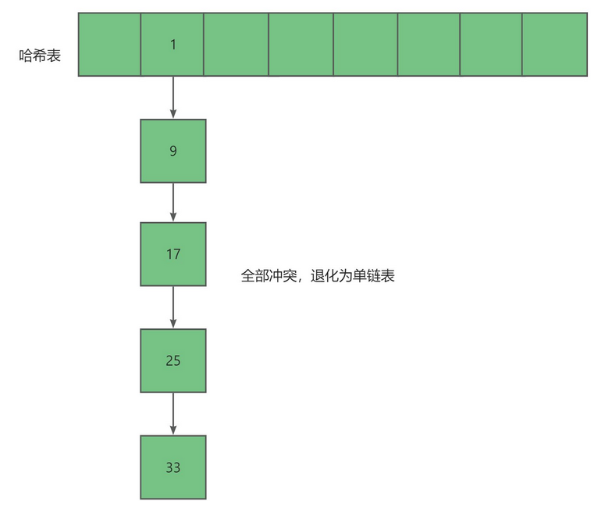
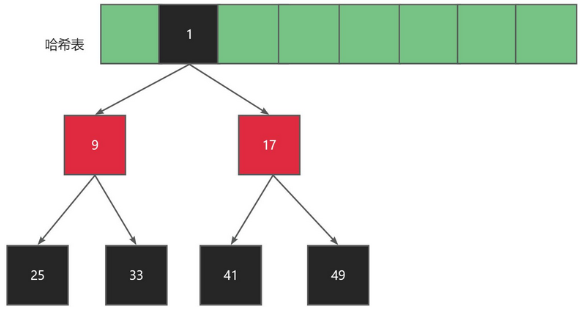
1.6.4 链地址法代码实现
代码如下(示例):
// 链地址法代码实现
namespace hash_bucket
{
template<class K, class V>
struct HashNode
{
pair<K, V> _kv;
HashNode<K, V>* _next;
HashNode(const pair<K, V>& kv)
:_kv(kv)
, _next(nullptr)
{}
};
template<class K, class V, class Hash = HashFunc<K>>
class HashTable
{
typedef HashNode<K, V> Node;
inline unsigned long __stl_next_prime(unsigned long n)
{
static const int __stl_num_primes = 28;
static const unsigned long __stl_prime_list[__stl_num_primes] =
{
53, 97, 193, 389, 769,
1543, 3079, 6151, 12289, 24593,
49157, 98317, 196613, 393241, 786433,
1572869, 3145739, 6291469, 12582917, 25165843,
50331653, 100663319, 201326611, 402653189, 805306457,
1610612741, 3221225473, 4294967291
};
const unsigned long* first = __stl_prime_list;
const unsigned long* last = __stl_prime_list +
__stl_num_primes;
const unsigned long* pos = lower_bound(first, last, n);
return pos == last ? *(last - 1) : *pos;
}
public:
HashTable()
{
_tables.resize(__stl_next_prime(0), nullptr);
}
// 拷⻉构造和赋值拷⻉需要实现深拷⻉,有兴趣的同学可以⾃⾏实现
~HashTable()
{
// 依次把每个桶释放
for (size_t i = 0; i < _tables.size(); i++)
{
Node* cur = _tables[i];
while (cur)
{
Node* next = cur->_next;
delete cur;
cur = next;
}
_tables[i] = nullptr;
}
}
bool Insert(const pair<K, V>& kv)
{
Hash hs;
size_t hashi = hs(kv.first) % _tables.size();
// 负载因⼦==1扩容
if (_n == _tables.size())
{
/*HashTable<K, V> newHT;
newHT._tables.resize(__stl_next_prime(_tables.size()+1);
for (size_t i = 0; i < _tables.size(); i++)
{
Node* cur = _tables[i];
while(cur)
{
newHT.Insert(cur->_kv);
cur = cur->_next;
}
}
_tables.swap(newHT._tables);*/
// 这⾥如果使⽤上⾯的⽅法,扩容时创建新的结点,后⾯还要使⽤就结
点,浪费了
// 下⾯的⽅法,直接移动旧表的结点到新表,效率更好
vector<Node*>
newtables(__stl_next_prime(_tables.size() + 1), nullptr);
for (size_t i = 0; i < _tables.size(); i++)
{
Node* cur = _tables[i];
while (cur)
{
Node* next = cur->_next;
// 旧表中节点,挪动新表重新映射的位置
size_t hashi = hs(cur->_kv.first) %
newtables.size();
// 头插到新表
cur->_next = newtables[hashi];
newtables[hashi] = cur;
cur = next;
}
_tables[i] = nullptr;
}
_tables.swap(newtables);
}
// 头插
Node* newnode = new Node(kv);
newnode->_next = _tables[hashi];
_tables[hashi] = newnode;
++_n;
return true;
}
Node* Find(const K& key)
{
Hash hs;
size_t hashi = hs(key) % _tables.size();
Node* cur = _tables[hashi];
while (cur)
{
if (cur->_kv.first == key)
{
return cur;
}
cur = cur->_next;
}
return nullptr;
}
bool Erase(const K& key)
{
Hash hs;
size_t hashi = hs(key) % _tables.size();
Node* prev = nullptr;
Node* cur = _tables[hashi];
while (cur)
{
if (cur->_kv.first == key)
{
if (prev == nullptr)
{
_tables[hashi] = cur->_next;
}
else
{
prev->_next = cur->_next;
}
delete cur;
--_n;
return true;
}
prev = cur;
cur = cur->_next;
}
return false;
}
private:
vector<Node*> _tables; // 指针数组
size_t _n = 0; // 表中存储数据个数
};
}
二、整体源代码实现
代码如下(示例):
//enum State
//{
// EXIST,
// EMPTY,
// DELETE
//};
//template<class K, class V>
//struct HashData
//{
// pair<K, V> _kv;
// State _state = EMPTY;
//
//};
//template < class K, class V>
//class HashTable
//{
//private:
// vector<HashData<K, V>> _tables;
// size_t _n = 0; // 表中存储数据个数
//};
//
//
//inline unsigned long __stl_next_prime(unsigned long n)
//{
// // Note: assumes long is at least 32 bits.
// static const int __stl_num_primes = 28;
// static const unsigned long __stl_prime_list[__stl_num_primes] =
// {
// 53, 97, 193, 389, 769,
// 1543, 3079, 6151, 12289, 24593,
// 49157, 98317, 196613, 393241, 786433,
// 1572869, 3145739, 6291469, 12582917, 25165843,
// 50331653, 100663319, 201326611, 402653189, 805306457,
// 1610612741, 3221225473, 4294967291
// };
// const unsigned long* first = __stl_prime_list;
// const unsigned long* last = __stl_prime_list + __stl_num_primes;
// const unsigned long* pos = lower_bound(first, last, n);
// return pos == last ? *(last - 1) : *pos;
//}
//#include<string>
//
//template < class K>
//struct HashFunc
//{
// size_t operator()(const K & key)
// {
// return (size_t)key;
// }
//};
//
// // 特化
//template < >
// struct HashFunc < string>
// {
// // 字符串转换成整形,可以把字符ascii码相加即可
// // 但是直接相加的话,类似"abcd"和"bcad"这样的字符串计算出是相同的
// // 这⾥我们使⽤BKDR哈希的思路,⽤上次的计算结果去乘以⼀个质数,这个质数⼀般去31, 131
// //等效果会⽐较好
// size_t operator()(const string & key)
// {
// size_t hash = 0;
// for (auto e : key)
// {
// hash *= 131;
// hash += e;
// }
// return hash;
// }
//};
//template<class K, class V, class Hash = HashFunc<K>>
//class HashTable
//{
//public:
//private:
// vector<HashData<K, V>> _tables;
// size_t _n = 0; // 表中存储数据个数
//};
namespace open_address
{
enum State
{
EXIST,
EMPTY,
DELETE
};
template<class K, class V>
struct HashData
{
pair<K, V> _kv;
State _state = EMPTY;
};
template<class K, class V, class Hash = HashFunc<K>>
class HashTable
{
public:
inline unsigned long __stl_next_prime(unsigned long n)
{
// Note: assumes long is at least 32 bits.
static const int __stl_num_primes = 28;
static const unsigned long __stl_prime_list[__stl_num_primes] =
{
53, 97, 193, 389, 769,
1543, 3079, 6151, 12289, 24593,
49157, 98317, 196613, 393241, 786433,
1572869, 3145739, 6291469, 12582917, 25165843,
50331653, 100663319, 201326611, 402653189, 805306457,
1610612741, 3221225473, 4294967291
};
const unsigned long* first = __stl_prime_list;
const unsigned long* last = __stl_prime_list +
__stl_num_primes;
const unsigned long* pos = lower_bound(first, last, n);
return pos == last ? *(last - 1) : *pos;
}
HashTable()
{
_tables.resize(__stl_next_prime(0));
}
bool Insert(const pair<K, V>& kv)
{
if (Find(kv.first))
return false;
// 负载因⼦⼤于0.7就扩容
if (_n * 10 / _tables.size() >= 7)
{
// 这⾥利⽤类似深拷⻉现代写法的思想插⼊后交换解决
HashTable<K, V, Hash> newHT;
newHT._tables.resize(__stl_next_prime(_tables.size() + 1));
for (size_t i = 0; i < _tables.size(); i++)
{
if (_tables[i]._state == EXIST)
{
newHT.Insert(_tables[i]._kv);
}
}
_tables.swap(newHT._tables);
}
Hash hash;
size_t hash0 = hash(kv.first) % _tables.size();
size_t hashi = hash0;
size_t i = 1;
while (_tables[hashi]._state == EXIST)
{
// 线性探测
hashi = (hash0 + i) % _tables.size();
// ⼆次探测就变成 +- i^2
++i;
}
_tables[hashi]._kv = kv;
_tables[hashi]._state = EXIST;
++_n;
return true;
}
HashData<K, V>* Find(const K& key)
{
Hash hash;
size_t hash0 = hash(key) % _tables.size();
size_t hashi = hash0;
size_t i = 1;
while (_tables[hashi]._state != EMPTY)
{
if (_tables[hashi]._state == EXIST
&& _tables[hashi]._kv.first == key)
{
return &_tables[hashi];
}
// 线性探测
hashi = (hash0 + i) % _tables.size();
++i;
}
return nullptr;
}
bool Erase(const K& key)
{
HashData<K, V>* ret = Find(key);
if (ret == nullptr)
{
return false;
}
else
{
ret->_state = DELETE;
--_n;
return true;
}
}
private:
vector<HashData<K, V>> _tables;
size_t _n = 0; // 表中存储数据个数
};
}
// 链地址法代码实现
namespace hash_bucket
{
template<class K, class V>
struct HashNode
{
pair<K, V> _kv;
HashNode<K, V>* _next;
HashNode(const pair<K, V>& kv)
:_kv(kv)
, _next(nullptr)
{}
};
template<class K, class V, class Hash = HashFunc<K>>
class HashTable
{
typedef HashNode<K, V> Node;
inline unsigned long __stl_next_prime(unsigned long n)
{
static const int __stl_num_primes = 28;
static const unsigned long __stl_prime_list[__stl_num_primes] =
{
53, 97, 193, 389, 769,
1543, 3079, 6151, 12289, 24593,
49157, 98317, 196613, 393241, 786433,
1572869, 3145739, 6291469, 12582917, 25165843,
50331653, 100663319, 201326611, 402653189, 805306457,
1610612741, 3221225473, 4294967291
};
const unsigned long* first = __stl_prime_list;
const unsigned long* last = __stl_prime_list +
__stl_num_primes;
const unsigned long* pos = lower_bound(first, last, n);
return pos == last ? *(last - 1) : *pos;
}
public:
HashTable()
{
_tables.resize(__stl_next_prime(0), nullptr);
}
// 拷⻉构造和赋值拷⻉需要实现深拷⻉,有兴趣的同学可以⾃⾏实现
~HashTable()
{
// 依次把每个桶释放
for (size_t i = 0; i < _tables.size(); i++)
{
Node* cur = _tables[i];
while (cur)
{
Node* next = cur->_next;
delete cur;
cur = next;
}
_tables[i] = nullptr;
}
}
bool Insert(const pair<K, V>& kv)
{
Hash hs;
size_t hashi = hs(kv.first) % _tables.size();
// 负载因⼦==1扩容
if (_n == _tables.size())
{
/*HashTable<K, V> newHT;
newHT._tables.resize(__stl_next_prime(_tables.size()+1);
for (size_t i = 0; i < _tables.size(); i++)
{
Node* cur = _tables[i];
while(cur)
{
newHT.Insert(cur->_kv);
cur = cur->_next;
}
}
_tables.swap(newHT._tables);*/
// 这⾥如果使⽤上⾯的⽅法,扩容时创建新的结点,后⾯还要使⽤就结
点,浪费了
// 下⾯的⽅法,直接移动旧表的结点到新表,效率更好
vector<Node*>
newtables(__stl_next_prime(_tables.size() + 1), nullptr);
for (size_t i = 0; i < _tables.size(); i++)
{
Node* cur = _tables[i];
while (cur)
{
Node* next = cur->_next;
// 旧表中节点,挪动新表重新映射的位置
size_t hashi = hs(cur->_kv.first) %
newtables.size();
// 头插到新表
cur->_next = newtables[hashi];
newtables[hashi] = cur;
cur = next;
}
_tables[i] = nullptr;
}
_tables.swap(newtables);
}
// 头插
Node* newnode = new Node(kv);
newnode->_next = _tables[hashi];
_tables[hashi] = newnode;
++_n;
return true;
}
Node* Find(const K& key)
{
Hash hs;
size_t hashi = hs(key) % _tables.size();
Node* cur = _tables[hashi];
while (cur)
{
if (cur->_kv.first == key)
{
return cur;
}
cur = cur->_next;
}
return nullptr;
}
bool Erase(const K& key)
{
Hash hs;
size_t hashi = hs(key) % _tables.size();
Node* prev = nullptr;
Node* cur = _tables[hashi];
while (cur)
{
if (cur->_kv.first == key)
{
if (prev == nullptr)
{
_tables[hashi] = cur->_next;
}
else
{
prev->_next = cur->_next;
}
delete cur;
--_n;
return true;
}
prev = cur;
cur = cur->_next;
}
return false;
}
private:
vector<Node*> _tables; // 指针数组
size_t _n = 0; // 表中存储数据个数
};
}